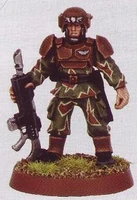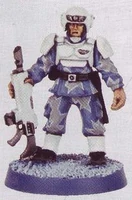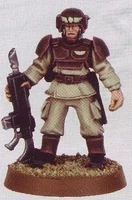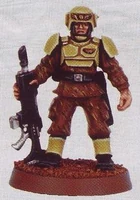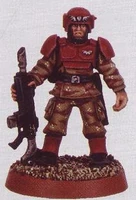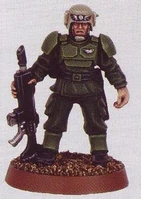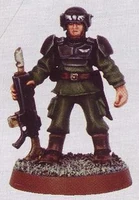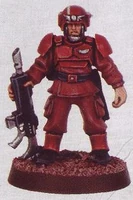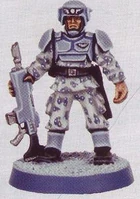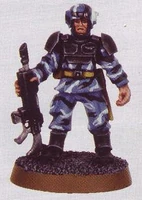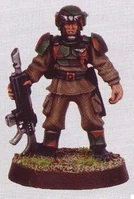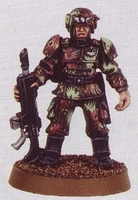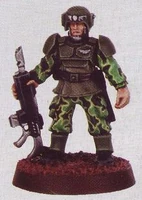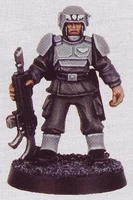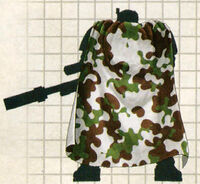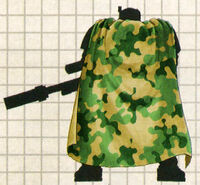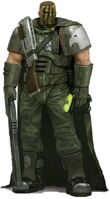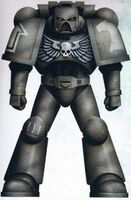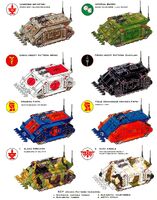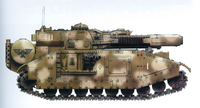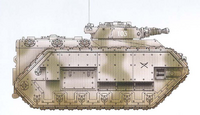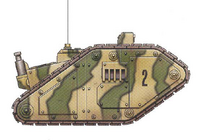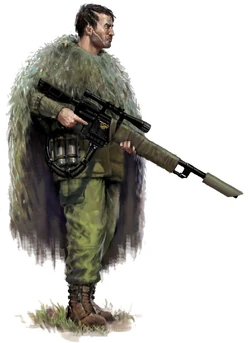
Tanith First-and-Only Imperial Guard trooper armed with a Hotshot Long-Las Sniper Rifle and a Cameleoline cloak
Camouflage is the art of hiding an individual or object from plain sight by utilising technological or natural means. This is done through the use of any combination of materials, colouration or illumination for concealment, either by making a person or object difficult to see (crypsis), or by disguising them as something else (mimesis). A third approach (motion dazzle) confuses the observer with a conspicuous pattern, making the visible object momentarily harder to locate. It is often used by the military forces of the various intelligent species of the Milky Way Galaxy.
Types of Camouflage[]
Camouflage was first practiced on Terra in simple form in the middle of the eighteenth century A.D. (ca. 750.M2) by rifle units. Their tasks required them to be inconspicuous, and they were issued green and later other drab colour uniforms. With the advent of longer range and more accurate weapons, especially the repeating rifle in the middle of the nineteenth century A.D. (ca. 850.M2), camouflage was adopted for the uniforms of all armies, spreading to most forms of military equipment including ships and aircraft. Many present-day camouflage textiles address visibility not only to visible light but also near-infrared, for concealment from night vision devices. Camouflage is not only visual; heat, sound, magnetism and even smell can be used to target weapons, and may be intentionally concealed. Digital camouflage applies patterns made of pixels, often designed to disrupt outlines at different distances, providing a degree of scale invariance.
Physical Camouflage[]
The majority of camouflage methods aim for crypsis, often through a general resemblance to the background environment, high contrast disruptive colouration, eliminating shadow, and countershading. This physical camouflage helps to conceal or break up the easily recognisable outlines of enemy forces.
Imperium of Man[]

Ice World/Winter Environment Camouflage Patterns
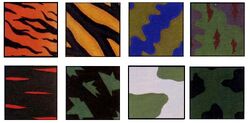
Death World/Jungle Environment Camouflage Patterns

Desert World/Desert Environment Camouflage Schemes
The camouflage utilised by the armed forces of the Imperium of Man is based on physical paint schemes, many of which are Codex Astartes approved schemes that will be utilised by Imperial Guard regiments and Space Marine Chapters. Both Departmento Munitorum manuals and the Codex Astartes details thousands of approved camouflage schemes in use throughout the Imperium. Every time an Imperial Guard regiment is raised, they are allocated a camouflage scheme, often one that is unique to them. This results in an endless variety of camouflage schemes suitable for any environment. Camouflage schemes often depend on the environment in which they will be fighting, as some planets have very different ecologies, geology and enviroments, some of which would seem quite garish to modern eyes. Some Chapters of the Space Marines adopt a "no camouflage" rule, instead adopting an attitude that they hope will intimidate their opposition through their refusal to make use of such tricks.
Listed below are only a small sample of the endless variety of camouflage schemes used by the military forces of the Imperium:
- Ice World/Winter Environment Camouflage Schemes - The troops of the Imperial Guard must fight in the harshest conditions, including the arctic wastes of Ice Worlds. Under these circumstances, winter camouflage becomes essential.
- Death World/Jungle Environment Camouflage Schemes - The vastness of the Imperium contains many jungle planets, most often classified as Death Worlds, which harbour a bewildering array of planet species, often with bizarre colouration. The Departmento Munitorum details camouflage schemes for even the strangest surroundings. The most famous of all Imperial jungle warfare regiments are those from the Death World of Catachan, the Catachan Jungle Fighters, with their distinctive red head bands and fearsome reputation.
- Desert World/Desert Environment Camouflage Schemes - The bleak wastes of the Desert World of Tallarn are not the only deserts encompassed by the Imperium. There are many arid worlds where the standard camouflage schemes are useless. There are, however, many camouflage schemes specially adapted to these conditions. It is not unusual for a regiment's vehicles to be painted in the same camouflage scheme as its troopers.
Scout Marine Camouflage[]
Space Marines rarely use any form of camouflage, for their entire combat doctrine states that they are best deployed as shock troops, their very presence filling the enemy with terror. There are instances when a Chapter may utilise patterns approved by the Codex Astartes, and in most cases this is in relation to the role of the Scouts. As ever, a Scout must be conversant in every aspect of war, and so an understanding of concealment and the use of camouflage are essential. The Codex contains a staggering array of camouflage patterns, many used in a wide range of environments. Others are intended for use in individual surroundings, and their use is extremely rare.
Orks[]
The Orks tend not to use camouflage, with two notable exceptions: the first is that of the Blood Axes clan who imitate the culture of the Imperium but do not understand the theory of camouflage and instead use combinations of colours and patterns with little relation to the environment in which they will be fighting, although it can sometimes prove effective. The second exception is that of Ork Kommandoz, those Ork Boyz who are "kunning az Mork", and are adept infiltrators and saboteurs, and use camouflage, misdirection and discreet movement with an aptitude baffling for such brutish creatures.
Tau[]
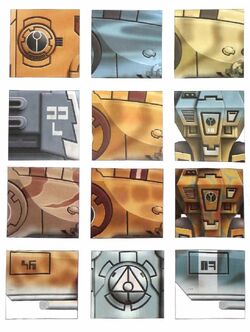
Various Tau vehicle colour schemes, markings, and badges
The Tau's approach to battlefield camouflage and identification largely remains a mystery to the Imperium's forces. To the casual observer, Tau vehicle camouflage utilises the same principles of concealment, confusion and recognition as the Imperium, but the Fire Caste have refined these principles to suit the Tau's method of waging war.
Tau patterns try to combine concealment and confusion aspects into one colour scheme. On the desert Mining World of Taros during the Taros Campaign, the vast majority of Tau Hunter Cadres used subtle diffused patterns with long blending distances. Given the distances that vehicles would be visible over open desert, this made perfect sense; providing the most effective camouflage at long range. Notably, most Tau vehicles and aircraft use a two-tone scheme, in which camouflage is added as another tone of the base colour, drawing on natural patterns which are often symmetrical. For example, a Devilfish transport in a blue night-time concealment and disruption pattern might be dark blue with lighter blue stripes. In this way, the Fire Caste has developed a system of camouflage that does not use contrasting colours.
Some Hunter Cadres, most likely those assigned to different battlefield roles, use variations of basic patterns. Tau Commanders are often given leeway to use their own personalised colour schemes if they wish. Tau Hunter Cadres also use a trim colour. This colour, used sparingly on all of a Hunter Cadre's vehicles, may be to aid recognition on the battlefield. Alternatively, there may be some traditional or ritualistic reason behind the choice of colour; the true reason often remains unknown to the Imperium.
Recognition of Tau vehicles does not seem to be an important issue. This may be due to their advanced communication and tracking technology, making visual recognition less of a factor for Tau forces, but this is little more than speculation. Vehicle markings and numbers are used, but are less intrusive than those found on Imperial Guard tanks and vehicles. The disciplined Fire Caste also does not allow the addition of slogans, vehicle names or kill markings (all common to the Imperial Guard) on their vehicles. On Taros during the Taros Campaign, no Tau vehicles were seen with such "unofficial" crew additions. There was also no instance of Tau forces being seen to employ campaign badges.
The principles of Tau vehicle numbering and lettering are unknown to the Imperium at this time. Notably, regardless of the Tau Sept from which a Hunter Cadre is drawn, all Fire Caste vehicles bear the badge of their caste, which is also the symbol of the race's homeworld Sept. Tau aircraft bear the badge of the Air Caste who serve exclusively as their pilots.
All Tau forces bear the colour of their Sept, usually in the form of a series of stripes applied to their weapons and/or armour. Whilst many Septs also have a preferred primary colouration for their forces, it is the Sept colour, and not the colour of their armour, that denotes which Sept the Tau warrior or vehicle hails from. However, whilst all members of a Sept bear the same Sept colour, the markings themselves may differ to distinguish between different teams and/or ranks. For example, white is the Sept colour of the T'au Sept, and this is shown on all Battlesuit and infantry armour as a series of stripes. Infantry squad leaders of the rank of Shas'ui are normally identified by the Sept colour also being applied to their sensor vane and/or shoulder plate. Tau Battlesuit pilots of the rank of Shas'ui, on the other hand, bear a single white sensor vane to denote their rank, whilst a Shas'vre Battlesuit team leader will bear a full white helmet. In turn, Tau Commanders piloting Battlesuits will often bear inverted primary and Sept colours on their helmet.
However, by no means are these colour schemes and patterns universal. The Tau are renowned for their adaptability in the theatre of war, and are willing to use alternate armour camouflage schemes to better suit their environments, such as lighter colours for snowbound worlds, darker colours during urban campaigns, or natural colours for jungle environments, as well as change their visual leadership identification markings to confuse the enemy. No matter what camouflage is displayed, however, the Sept colour will remain the same throughout.
Necrons[]
The Necrons are not known to utilise camouflage patterns.
Holographic Camouflage[]
Some races use holographic technology to either completely conceal or generate disruptive patterns that dazzle or confuse the viewer:
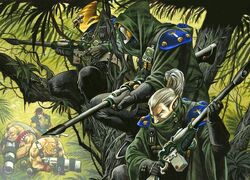
Eldar Rangers utilising Cameleoline Cloaks and the natural camouflage of their environment, stalk an Imperial Guard regiment of Catachan Jungle Fighters on a jungle Death World
- Cameleoline Cloaks - Cameleoline Cloaks are used by a number of races to provide camouflage for their elite infantry. Cameleoline is a refractive chemical substance that morphically blends its colouration into the surrounding area. It is often woven into cloaks and smocks, or more rarely, as a coating over armour plate. Its properties aid with concealment during covert assaults.
- Holo-Fields - Typically the Eldar and Dark Eldar use holographic technology on their vehicles and starships. A Holo-Field, called Dathedi in the Eldar Lexicon, is an integral part of the defensive military technology employed by the starships and vehicles of the Eldar. Unlike the Imperium of Man, which makes use of powerful gravitic shielding known as Void Shields to protect its warships and large vehicles like Titans, the Eldar have chosen to maximise their advantages in speed, stealth and deception when protecting their vehicles and warships. A Holo-field is a three-dimensional photonic projection created by a computer-controlled network of special laser projectors that create a field of visual distortion around a vehicle or starship. This distortion makes it extremely difficult to target the vehicle or vessel so protected either by using computer-assisted targeting or by eye, since the projection distorts both electronic and physical perception of the actual location of the object generating the Holo-field.
- Holo-Suits - Warriors such as the mysterious Harlequins utilise sophisticated Holo-Suits, which employ individual forms of the Eldar Dathedi technology to fragment their image and baffle incoming fire.
- Stealth Field Generators - Tau XV15 Stealthsuits and XV25 Stealthsuits also possess the capability of camouflaging its wearer through the use of their stealth technologies. The suit's integrated holographic disruption field achieves its effects through a number of disruptor emitter nodes arrayed all over the Battlesuit's armour. This holographic disruption field can operate in two modes. The default, passive mode utilises a range of technologies to dampen the suit’s electromagnetic signature so that enemy scanners are far less likely to detect it. This mode is called "passive" because its use cannot be detected, as rather than attempting to interfere with enemy sensor systems, it simply masks the suit itself. In active mode, however, the suit's stealth field generator comes online. The suit's matte finish ripples and blurs, resolving itself into a nigh-perfect representation of the terrain that lies behind it; making the suit and its wearer all but transparent -- even to visual identification. In this way, the Stealthsuit's form is blended into the background as if its wearer was a Terran chameleon. In addition, when operating in active mode, the Stealthsuit's systems are actively interfering with and jamming enemy sensor devices. In so doing, the jamming itself may give away the fact that a Stealthsuit is present somewhere on the battlefield, but it will make the detection of its actual location nearly impossible, thus allowing the Stealthsuit-clad warriors to move untracked, blending in with their surrounding environment before they strike. Because it is hard to focus on their location, a Stealth Team can hide to at least some degree even when standing in open territory. In areas of cover, such as forests or the rubble of an embattled city, they can effectively fade into the background, making themselves extremely difficult targets for enemies to mark out or lock on to effectively.
Natural Camouflage[]
Some factions have specific troop types that are able to physically alter their forms (eg. the Imperial Officio Assassinorum's Callidus Temple Assassins), or their natural colouration (eg. Tyranid Lictors) to better blend in with their surroundings.
Sources[]
- Apocalypse (6th Edition), pp. 180-181
- Apocalypse (4th Edition), pg. 161
- Apocalypse Reload, pg. 47
- Codex: Assassins (3rd Edition), pp. 3, 6
- Codex: Assassins (2nd Edition), pp. 12-14
- Codex: Astra Militarum (6th Edition), pp. 222, 288
- Codex: Imperial Guard (3rd Edition, 2nd Codex), pg. 31
- Codex: Imperial Guard (2nd Edition), pp. 48-51
- Codex: Eldar (6th Edition), pg. 65
- Codex: Militarum Tempestus (6th Edition), pp. 54, 56-57
- Codex: Tau Empire (6th Edition), pp. 43, 68-71, 79, 87, 100
- Codex: Tau Empire (4th Edition), pp. 27, 35
- Codex: Tau (3rd Edition), pp. 16, 25, 35, 60
- Codex: Tyranids (5th Edition), pg. 41
- Deathwatch: Core Rulebook (RPG), pp. 366-367
- Deathwatch: The Achilus Assault (RPG), pg. 16
- How To Paint Space Marines (2004), pg. 40
- Imperial Armour Volume One - Imperial Guard & Imperial Navy
- Imperial Armour Volume Three - The Taros Campaign, pp. 78, 282, 284, 314-315
- Inquisitor: The Thorians (Background Book) by Gav Thorpe, pp. 16-17
- Warhammer 40,000: Rogue Trader (1st Edition), pg. 170
- White Dwarf Magazine 321 (UK), "The Kappa Mortis Incident", pp. 76-81
- White Dwarf Magazine 312 (UK), "Silent Menace - Space Marine Scouts," by Andy Hoare, pg. 47
- White Dwarf Magazine 246 (UK), "A Rough Guide To Painting The Land Raider" by Nick Davis & Mark Jones, pg. 27
- White Dwarf Magazine 143 (UK), "Armies of the Imperium: Imperial Guard Colour Schemes," by Rick Priestley, pp. 63-69
- White Dwarf Magazine 105 (UK), "Chapter Approved: Land Raider", pg. 3
- White Dwarf Magazine 103 (UK), "Rampaging Rhinos" by Rick Priestley, pp. 64-65





